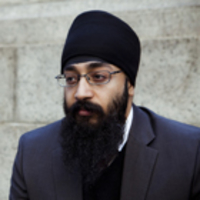Ten years ago this week, French president Jacques Chirac signed Law 2004-228, or the “French headscarf ban” that would ignite a decade of religious contention in the country. Though couched in general language—prohibiting the wearing of “conspicuous” religious dress—the law disproportionately impacts minority religious groups and directly interferes with numerous basic human rights.

The ban disproportionately prevents primary and secondary school children of Muslim, Sikh, and Jewish communities from freely exercising their religious beliefs. While wearing the headscarf, turban, and yarmulke are barred without exception, Christian crosses are considered “discreet,” and therefore, exempt from the ban.
The U.N. Human Rights Committee in 2012 issued a binding decision in Bikramjit Singh v. France that found France is in violation of Article 18 (Religious Freedom) of the International Covenant on Civil and Political Rights (ICCPR).
Although the issue of religious freedom grabs the media spotlight, other human rights of French children are also implicated.
In the name of “strict secularism” (or laïcité), France has imposed severe limitations on children’s fundamental rights to develop their internal belief systems and identities while communicating those beliefs in the marketplace of ideas.
On a more practical level, this policy interferes with a student’s fundamental human right to an education and the parents’ fundamental right to direct the education of their children in a manner consistent with their value systems.
By marginalizing members of minority religious groups, France, as the U.S. commission on international religious freedom (USCIRF) put it, has forced students to make the “untenable choice between practicing their faith [and] obtaining a proper education.” That is a Hobbesian choice that no child deserves to make.
France has consistently demonstrated its utter refusal to address this violation by enacting and proposing heightened restrictions on religious expression. In 2011, the country’s lawmakers doubled down on their restrictions on expression, banning the wearing of full-face veils. Though neutral on its face, the national debate leading up to this legislation and the variety of exceptions make it clear that France was targeting the Islamic burqa and niqab. Recently, President Fraçois Hollande has also called for extending the “headscarf ban” to private employers and universities.
Next March, France will again face a review before the U.N. Human Rights Committee. If you were just to read Hollande’s public statements, you may think that France was amenable to change its policy at the request of the international community. For example, Hollande’s recent statements on intolerance emphasized combating this injustice with “a crackdown” on intolerance and an “educational” program. And France has consistently argued in their briefs to the United Nations that the ban on outward religious symbols is limited only to public primary and secondary schools.
Unfortunately, lofty rhetoric does not mend the shattered dignities and identities of Muslim, Sikh, and Jewish children due to systemic human rights violations at the hands of French policy makers. And not only has France failed to mend, it has picked up a sledgehammer.
It’s time for France to replace canned statements with meaningful action, which means adhering to the recommendations set forth by the U.N. Human Rights Committee that require France to stop implementing the headscarf ban in a discriminatory manner. In the meantime, we must continue reminding France of the impact this anniversary has on French society and its future generations.







